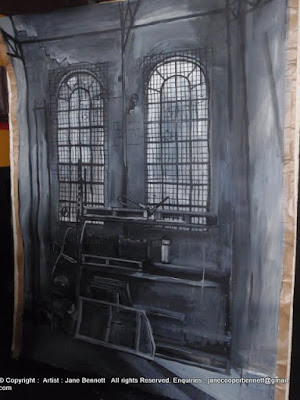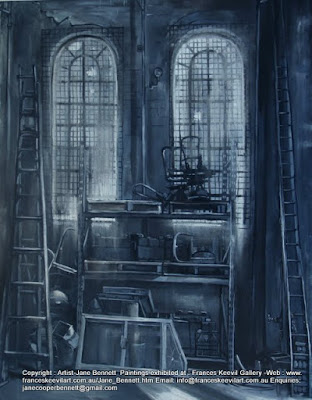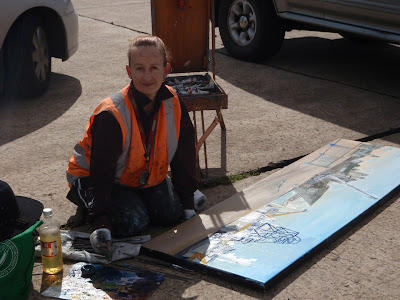One door closes...
Early in 2012 renovations started on some parts of the interior and exterior of the Large Erecting Shop at Eveleigh. New wooden doors made to the original pattern and drawings replaced the corrugated iron doors on all 6 roads.
Wrought Artworks, the blacksmith's forge, in Bay 1/2 south of the ATP had their massive wooden doors replaced.

Painting E77 'The corner windows, Large Erecting Shop'
2011 ink/acrylic on paper 131 x 115cm.
I painted a series of paintings of the doors and windows of the Large Erecting Shop before their makeover.

Painting E77 'The corner windows, Large Erecting Shop'
2011 ink/acrylic on paper 131 x 115cm
I have mixed feelings - I loved the brooding atmosphere and quirky
imperfections caused by decades of soot, industry and vandalism, yet I'm
glad that at least a token gesture has been made to respecting and conserving the
building's heritage.

Painting E77 'The corner windows, Large Erecting Shop'
2011 ink/acrylic on paper 131 x 115cm.
Available
However, apart from fixing holes in the roof, the improvements seemed to be restricted to the purely cosmetic rather than structural - the power, lighting and water supply, which could well stand some serious improvements, didn't seem to be on the list.

Painting E77 'The corner windows, Large Erecting Shop'
2011 ink/acrylic on paper 131 x 115cm
The strange skeletal silhouettes against the windows are the relics of old train seats stacked madly against the grill!
Shapes would emerge and sink back into the gloom as railway workers opened and closed the doors.
Shapes would emerge and sink back into the gloom as railway workers opened and closed the doors.

Painting E77 'The corner windows, Large Erecting Shop'
2011 ink/acrylic on paper 131 x 115cm.
Available
In the darkness I could barely make out the forms of motley bits of decades of collected junk; a shelf of old batteries sitting on rotting pallets,a couple of seats, a carriage window with panes of smeared and broken glass. This is flanked by a nest of ladders -I thought at first there were snakes behind them, but instead there is a cluster of bits of pipe. Around the base of the ladder to the right lie a stack of old brakes, which at first sight resembled blocks of wood.

Painting E77 'The corner windows, Large Erecting Shop'
2011 ink/acrylic on paper 131 x 115cm.
Available
But most of it is wonderfully incomprehensible and fabulously useless.

E77 'The corner windows, Large Erecting Shop' 2011
ink/acrylic on paper 131 x 115cm.
Available
The finished painting in glorious monochrome.
Related posts
Macdonaldtown - A Station without a suburb




















